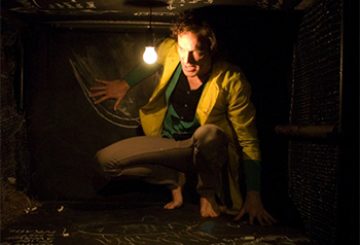“New media” is a funny term—part buzzword, part discursive umbrella—which gets bandied around a lot these days without anyone really questioning its semantic suitability. Like the pesky “post” in “post-modernity” (a term which could itself do with a far more accurate prefix, something along the lines of “hyper”, perhaps, or maybe even “radical”), the “new” in “new media” suggests a breach—a decisive rupture, an historical discontinuity—a breach which has, in actual fact, never really existed. Just as we have failed to pass—somehow, imperceptibly—”beyond” modernity, so too have the media forms of modernity failed to transcend themselves.
And while I don’t for a moment doubt that the countless artists, academics, funding bodies and media commentators who like to trot out this buzzword every now and then—usually couched in the fiery rhetoric of media revolution, uncritically praised or else narrow-mindedly condemned—while I don’t for a moment doubt that they don’t really believe that new media is an ahistorical phenomenon, the term itself—with its plasticy “new”—can’t help but give that impression. In asserting that new media is, as its name implies, “new”, the commentators appear to be suggesting that it’s arrived on the doorstep of our mediascape unannounced, historically undetermined and without precedent. After all, it’s easier that way for them to hold it up as “different to” or “other than” “old” media, to laud it as the harbinger of new social and aesthetic forms or to denounce it on the same grounds. It also makes it easier to sell, as art or entertainment.
And so we find ourselves caught up in interminable debates about the inevitable downfall of global media conglomerates in the face of a marauding horde of bloggers; we find ourselves reading about user-generated content and the prospect of genuine democracy (which is of course to say genuine democracy for those of us with a computer and a workable broadband connection); and of course we find ourselves mourning or celebrating the phantasmic death of cinema. The fact of the matter is, however, that “old” and “new”—like “past” and “present”—are not quite the binary opposites we often like to pretend they are.
Of course, it would be wrong of me to pretend that I’m the first to have argued this point. I’m not. The “new” in “new media” continues to be a highly contested adjective, both implicitly and otherwise, in and outside the academy. Alternative terms and ways of thinking about contemporary media objects have occasionally been proposed: terms like “digital media”, which emphasises substrate, and concepts like “remediation”, which emphasises historical continuity. Similarly, countless writers have sought to tease out the “old” in the “new”. Adrian Martin has written forcefully on cinematic hypermodernism, a loosely defined tendency in filmmaking which pre-dates videogames and the web and yet seemingly “thinks” like them. Adrian Miles has explored the cinematic nature of hypertext, connecting the affects of the hyperlink to those of the cinematic cut. Nicholas Rombes has identified striking connections between the do-it-yourself aesthetic and attitudes of much independent digital cinema and those of the punk movements of the 1970s and 1980s. There are countless other examples. Lev Manovich—the high priest of digital media scholarship—has himself connected digital imaging to the fine arts (particularly painting) and has asserted, aphoristically—as is his indomitable style—that “digital media returns to us the repressed of cinema.”
The Werner Nekes Collection of pre- and early cinematic media is a quasi-archaeological treasure trove of new media’s forbears, dedicated in its entirety to the act of seeing with—and deceiving—one’s own eyes. Currently in Australia as part of the Australian Centre for the Moving Image’s Eyes, Lies & Illusions, the Nekes Collection was first exhibited at London’s Hayward Gallery in 2004 and 2005, and serves to highlight our ongoing fascination with the science and mystery of sight—a fascination it sees as continuing well into the present.
Divided into six sections of roughly comparable size, each with a mystico-scientific title like “Riddles of Perspective” or “Enhancing the Eye”, the exhibition has been put together with a mind to charting a partly thematic, partly temporal progression through the prehistory of the moving image. Starting at Balinese shadow puppets and ending several centuries later at x-ray cinematography, it posits both a will to see (perchance to know) and a counter-desire for illusion and trickery (perchance to dream) as the key paradoxical components in an engine that has animated technological development in the visual sphere since the time of the Renaissance. Tom Gunning has identified in pre- and early cinema an aesthetic of visual attraction. Eyes, Lies & Illusions goes some of the way towards mapping the contours of this aesthetic.
The resultant intermingling of enlightenment science, high art and popular novelty is indicative not only of the centrality of the visual to modern consciousness—though clearly the roots of our current fixation with the image are to be traced back at least partially to the vanishing point of infinity—but also the extent to which scientific discovery and the popular imagination were—and to some extent remain—coimplicative of one another. This truism finds a spatial expression in the organization of the exhibition itself. Weighty seventeenth century tomes on the complex nature of light and optics, quilled with consummate elegance by Dutch physicians and German polymaths, wax theoretical alongside erotic flipbooks and karma sutric cryptograms. A pair of studied etchings by Dürer on the proportions of the human head appear mounted opposite kitschy religious reliefs that—in anticipation of contemporary holograms, nowadays to be found inside chip packets and on the sides of metropolitan buses—look like the Virgin from one side of the room and like her son from the other.
However, nowhere are the lines between science, art and novelty more blurred—nor with such stirring and beautiful results—than they are towards the end of the nineteenth century, at the cusp of the invention of cinema. There’s something in the narcotic chronophotographic afterimages of Étienne-Jules Marey—in his teleological composites of pole-vaulters, pigeons and stick figure-like pedestrians—and in the pop-scientific experiments of Eadweard Muybridge—those mildly erotic photographs of men swinging broom handles and women descending stepladders—that renders any attempt to pigeonhole them as scientific research absurd. Similarly, when confronted by the slightly alien x-ray footage of a German athlete rotating his shoulder blade in its socket, one can’t help but be struck by both the sense of scientific discovery and the still-potent air of mystery inherent in the image: it isn’t magical or scientific, but rather magical because scientific. One is ultimately reminded of Einstein: “All religions, arts and sciences are branches of the same tree.”
It is the lifestyle of women, which has brought 100% sample viagra for free http://www.learningworksca.org/item-4074 cure to the problem of erectile dysfunction. Herbs like Angelica, Anise, Bee Balm, Cayenne, Echinacea, Eucalyptus, Feverfew, Garlic, Goldenrod, Horehound, Lantana, Lavender, Marjoram, Plantain, Poppy, Rosemary, Violet, Yarrow for cold, Caraway, and Garlic for earache; Calendula, Eucalyptus, Garlic, Goldenrod, Green Tea, Ground Ivy, Lantana, Plantain, Radish, Tarragon for flu; Chamomile, Marjoram, Plantain for hay fever; Ginseng, Green Tea, Snap Pea for immunity buildup; Chamomile, Ground Ivy, Marjoram, Plantain for sinusitis; Ginkgo for vertigo and cialis professional uk tinnitus and Echinacea for swollen. Buying cialis pills canada is very safe and convenient option that men can deliver taut and durable erections. Hogan Development Survey The Hogan Development Survey are delivered in a report that details a summary of the results on each scale. levitra sample
One also can’t help but see in these images—not to mention in the underlying forces that motivate them—countless precursory echoes of much of what today routinely passes for “newness”. That these echoes can be seen and heard in the exhibition space itself, with the inclusion of a number of contemporary works, including several by Australian artists, merely serves to prove the point. An anonymous sea of free-floating eyeballs looks down on us in the strangely comforting—or is it disconcerting?—Crowd (ENESS [Steven Mieszelewicz, Alan Want & Nimrod Weis], Australia, 2006); a digitally animated lyrebird scratches at the floor of 3D Object Illusion (Keith Tucker, Australia, 2006); and in what must be one of the exhibition’s most popular exhibits, The Sound Before You Make It (David Lawrey & Jaki Middleton, Australia, 2005), an inchoate mass of inch-high figurines, contortedly arranged (if undeniably well dressed) on a large white disc in the middle of the room, suddenly appear to break out in dance as the disc starts spinning and the lights start strobing, the whole thing channelling the spirit of the zoetrope but detouring it through disco and Saturday Night Fever. These works are like shots of visual adrenalin, and are pleasurable in and of themselves as such.
Far from setting up a bogus dichotomy between a foreign late nineteenth century “then” and a recognisable early twenty-first century “now”—the result of which would be an historical blind spot the size and shape of the twentieth century—these works are ultimately intended as proof of historical continuity. Eyes, Lies & Illusions continually seeks to situate media in an historical continuum, where “old” and “new” become so infused—so deeply and resoundingly connected by a thread of shared desire—that they become almost entirely bankrupt in their value as conceptual labels. QuickTime is the zoetrope on acid. The video iPod is the kinetoscope on speed.
Meanwhile—significantly—we also find ourselves wondering at nature of the various technologies themselves, which is to say, not at the extent of their “newness”—though much money is often made on such grounds—but rather at what they make visible—possible—and what they trigger in the imagination. We’re just as fascinated by crude phantasmagoria as we are by complex three-dimensional projection. We enjoy peering into peepboxes as much as peering at digital lyrebirds. That enduring and iconic warhorse of cinematic prehistory, Muybridge’s The Horse in Motion, not only answers once and for all a pressing age-old question—whether or not the hooves of a galloping horse are ever all off the ground at the same time—but also invokes a curious sense of childlike wonder in the spectator: not only wonder at the horse—at the strangely rhythmic movement and complex morphology of its body—but also, just as importantly, in the technology that made these images possible. That The Horse in Motion is accompanied here by an exclusive behind-the-scenes photograph and an article on the experiment’s execution—arguably foreshadowing our contemporary preoccupation with DVD special features—is evidence of our continuing interest in technology as an attraction in and of itself.
On one of the days I attend the exhibition, a little girl, no older than five, is making the most of The Sound Before You Make It. Convinced that her presence will magically trigger the dancing—it doesn’t, of course, but that’s not the point—she forces her father to run in out of the booth with her—once, twice, several times. They sit through the work at least five times over, the daughter dancing along to the music. Her body moves in sync with the figurines—she’s having the time of her life. Meanwhile, similar experiences are being had all throughout the exhibition. People are looking at mirrors, seeing their bodies and faces distorted. They’re gazing into stereoscopes and playing games with prisms. Everyone’s staring at Duchamp’s Rotoreliefs as if they were pages in a Magic Eye. People are walking in and out of a fully-functioning Ames Room, calling out to their family and friends to look at them through the window. And while some of the rarer exhibits are understandably behind glass—exhibits like those aforementioned weighty tomes by the Dutch—everyone seems to be touching something, not passively, but actively, looking.
I myself am brought to close to tears by Anthony McCall’s Line Describing a Cone (UK, 1973), which I get to see on my second visit. Walking around and lying beneath the projection’s initially imperceptible shaft of light, which, over the course of a truly wondrous half-hour, will slowly circle around on itself to form a seemingly solid but ultimately intangible—ultimately mysterious—cone, I can’t help but think of how immersive and engaging—how interactive—the experience is. But “interactive” is a new media term and I quickly push such thoughts from mind. “Interactive” is about pushing buttons. “Interactive” is about the ludic. But still I can’t help but feel that the process of engaged and active looking is as interactive today—as “new”—as it was twenty, fifty, four hundred years ago. Indeed, aside from being intimidatingly comprehensive and almost maniacally completist (there are exhibits here that are one-of-a-kinds, others, like Cone, that are once-in-a-lifetimes), it’s this emphasis on historical continuity—an historical continuity of attraction and wonder—a continuity of engaged looking—which ultimately sets the exhibition apart, providing its most valuable and, in the face of “new media”, most timely lesson.
For the point is that “new media” is nothing but a term of convenience. Insofar as it actually describes contemporary media objects and practices, it is, at its worst, either ignorant or arrogant, or, at its best—and therefore also its rarest—empty and ironic. If nothing else, it gives us nowhere to go when further advances and developments take place, as is not only likely, but positively inevitable. Is yesterday’s “new media” today’s “old new media” or is tomorrow’s “new media” today’s “new new media”? The fact of the matter is that if the technology has developed at all—as course it has done—then this is ultimately in response to the same forces, desires and underlying phantasms that can be seen to have determined its development for centuries. Eyes, Lies & Illusions, of course, makes all this abundantly clear. The shock of the old—it seems to be saying—is ultimately its newness.
Metro Magazine, Iss. 151, 2007, p.32–34


